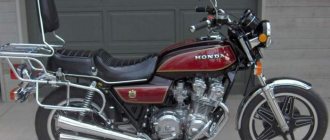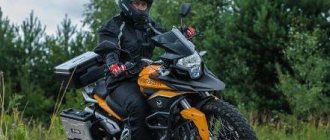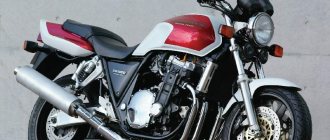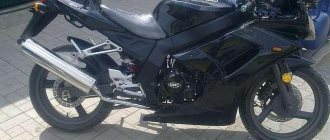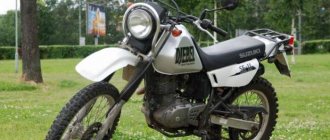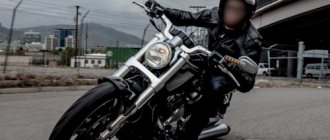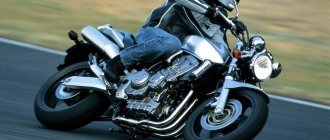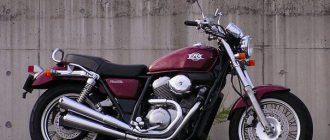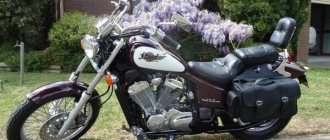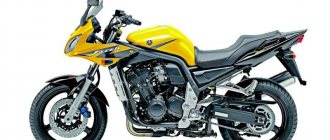- motorcycle model, Honda brand,
The budget sports motorcycle model Honda CBR400R was first introduced in 2013 as a domestic modification of the Honda CBR500R. Both models are almost identical to each other and differ only in the engine configuration - the Honda CBR400R engine reduced the crankshaft stroke and increased the compression ratio.
The basis of the Honda CBR400R was an in-line 2-cylinder liquid-cooled engine with a volume of 399 cm³ and producing 46 hp. power and 37 Nm of torque. Maximum engine performance is achieved from 7500 to 9500 rpm.
Other features of the model include a steel frame, simple suspension, single-disc front brake, fuel injection system, 6-speed gearbox, versions with ABS and 192 kg curb weight.
In 2021, the Honda CBR400R model (like the export Honda CBR500R) was restyled, receiving a new appearance, front suspension adjustment and an increase in the fuel tank by 1 liter.
Currently, the Honda CBR400R model is widely represented at Japanese auctions with prices starting from $4,500 including delivery.
The main competitors of the Honda CBR400R in the class:
Kawasaki Ninja 400
Yamaha YZF-R3
Dimensions and weight
The motorcycle has average dimensions for the class: its wheelbase is 1375 mm, its height is 1080 mm, its length is 1990 mm, its width is 670 mm, and its seat height is 750 mm. The weight of the CBR 400 RR is 170 kg, and its tank volume is 15 liters. Fuel consumption greatly depends on driving style. In an aggressive sports race, up to 10 liters can be spent per hundred kilometers, while during quiet movement, about 5 liters can be spent.
Description of the motorcycle
Honda CBR 400 and its technical characteristics:
- dry weight – 163 kg;
- length – 1990 mm;
- width – 670 mm;
- height – 1080 mm;
- seat height – 750 mm;
- wheelbase – 1375 mm;
- Max. speed – 185 km/h;
- acceleration 0-100 km/h – 4.5 seconds;
- fuel tank volume – 15 l;
- average fuel consumption in quiet mode – 5-6 l/100 km;
- Fuel consumption during aggressive driving is up to 10 l/100 km.
Engine
The power unit, despite its modest volume of 400 cubic meters, had 4 cylinders arranged in a row. However, for the Japanese this fact was not surprising. In the 80s, the Japanese produced 6- and 8-cylinder sports engines for the domestic market. The engine characteristics look good even in our time:
- cylinder volume – 399 cm³;
- cylinder diameter – 55 mm;
- piston stroke – 42 mm;
- compression ratio – 11.0;
- Max. power – 59 l. With. at 12500 rpm. (since 1993 reduced to 53 hp at the same speed)
- Max. torque – 39 Nm at 10,000 rpm.
The power unit had an overhead valve arrangement (DOHC) with 4 valves per cylinder and a gear-driven camshaft. The cooling system is liquid. The ignition system is digital, using transistors.
The power system consisted of 4 Keihin carburetors (one for each cylinder). The carburetors themselves are of the flat-throttle type with jets with a diameter of 26 mm.
Honda CBR 400RR
Transmission and chassis
The motorcycle was equipped with a manual 6-speed gearbox. The rear wheel was driven by a steel chain. The frame is diagonal, made of aluminum alloy.
The front fork is telescopic, Showa brand, with preload adjustment and stays with a diameter of 41 mm. The rear suspension consisted of a progressive monoshock absorber with adjustable preload and compression ratio. The brakes were hydraulic. The front brake mechanism is 2-disc, floating type, with 4-piston calipers and disc diameter 275 mm. The rear brake mechanism is single-disc, with a 2-piston caliper and a disc with a diameter of 220 mm.
Tire sizes: front – 120/60-17, rear – 150/60-18.
Honda CBR 400RR
The Honda CBR400RR was produced for 11 years and gained wide popularity in Japan and abroad, being sold unofficially in the markets of many countries.
The secret of the bike’s popularity lies, first of all, in its price. Unlike more serious sports motorcycles, the Honda CBR400 was more accessible to the average consumer and delivered good performance for the money.
The motorcycle is comfortable enough for city use, and the technical characteristics of the Honda CBR 400 make it suitable for sports competitions. The designers managed to achieve good handling on any road, reliability in extreme conditions and comfort for the driver.
Nowadays, the Honda SBR 400 RR is often recommended to novice motorcyclists for its high-torque and flexible engine, lightness and simplicity of control, which forgives many mistakes. At the same time, despite its modest volume, the device is capable of spirited driving and provides driving pleasure.
Chassis and brakes
The frame of the bike is diagonal and made of aluminum. The latter circumstance makes the motorcycle lighter and much more in line with the sporty direction of the motorcycle than, for example, a steel one. The wheels are alloy and look very elegant, despite their simplicity.
At the rear, a progressive monoshock absorber is used as suspension. At the front, a 41 mm telescopic fork is used. The rear brake features a 220 mm disc along with a two-piston caliper, while the front uses a pair of 275 mm discs along with four-piston calipers.
Specifications
In terms of its parameters, this motorcycle is very good. Its performance even today is impressive and makes the model interesting for those who want to buy a cheaper motorcycle, but in good condition. This is a reliable car that has a very long service life, so even if it has been driving for more than a dozen years, its condition can be excellent.
Engine
The inline four shows good maximum performance: torque is 40 Nm and power is 53 hp. These are not such small figures for a unit with a volume of 399 cm³. The speed limit here is 190 km/h. For a small entry-level sportbike, you don’t need anything more powerful.
Class
| Classic 9 Sports 14 | Streetfighter 2 |
Engine capacity
docub. cm.
Transmission
The gearbox here is six-speed, and the drive is of a chain type. Thanks to this transmission, the Honda CBR 400 RR can accelerate well in any of the six gears. In addition, due to the type of drive, power is not lost when the motor potential transfers to the wheel.
Dimensions and weight
The motorcycle has average dimensions for the class: its wheelbase is 1375 mm, its height is 1080 mm, its length is 1990 mm, its width is 670 mm, and its seat height is 750 mm. The weight of the CBR 400 RR is 170 kg, and its tank volume is 15 liters. Fuel consumption greatly depends on driving style. In an aggressive sports race, up to 10 liters can be spent per hundred kilometers, while during quiet movement, about 5 liters can be spent.
Chassis and brakes
The frame of the bike is diagonal and made of aluminum. The latter circumstance makes the motorcycle lighter and much more in line with the sporty direction of the motorcycle than, for example, a steel one. The wheels are alloy and look very elegant, despite their simplicity.
At the rear, a progressive monoshock absorber is used as suspension. At the front, a 41 mm telescopic fork is used. The rear brake features a 220 mm disc along with a two-piston caliper, while the front uses a pair of 275 mm discs along with four-piston calipers.
Fuel consumption
The average fuel consumption of the Honda CBR 400 RR is 5-6 liters in quiet mode and up to 10 liters per 100 km in aggressive driving style.
Model overview
40 years of evolution and technical progress have given us today a fairly powerful, compact, beautiful and technically well-equipped middle-class motorcycle - the Honda CB 400 Super Four Hyper VTEC 4 versions REVO and BOLDOR. The motorcycle is equipped with a 4-cylinder, 16-valve water-cooled engine with a displacement of 399 cm³.
The car was created for the Japanese domestic market, because there are restrictions for beginner motorcyclists: the engine volume should not exceed 400 cm³, and the power should not exceed 53 hp. The engine is also equipped with an electronic injection system PGM-FI Fuel and a VTEC system.
VTEC works as follows: because the engine is 16-valve (4 valves per cylinder), then from 1st to 5th gear up to 6300 rpm only 2 valves per cylinder are used in the engine operation, the second pair of valves is activated above 6300 rpm and at a fully open throttle to increase power . In 6th gear, all 16 valves are engaged in engine operation.
The appearance of the motorcycle leaves no one indifferent - not only the driver gets pleasure from riding it, but also all passers-by turn around and follow this beautiful car with their eyes.
In terms of design, the motorcycle belongs to the “naked bike” class: it completely lacks plastic panels and fairings, the headlight is round, and the speedometer and tachometer are not covered in any way. The exception is the BOLDOR version: it is equipped with a front fairing and a square headlight .
The riding position on the motorcycle is classic, not sporty, so long-distance trips are not tiring, but for them it is better to have at least a little wind protection, or a BOLDOR version with a fairing: the motorcycle reaches a maximum speed of up to 190 km/h, which is quite a high figure, and At such speeds, drag increases greatly.
The motorcycle is very practical, has a relatively light weight, and is compact in size, making it well suited for dense city traffic and maneuvering between cars in traffic jams.
The motorcycle has a fairly powerful braking system - a large 2-disc brake at the front and a single-disc brake at the rear. The motorcycle has high dynamic characteristics - it accelerates to 100 km/h in 4.5 seconds.
All models of Honda motorcycles in the lineup have impressive characteristics, in each group of motorcycles by type.
Fuel consumption per 100 km in city mode is 4-8 liters, depending on the driver’s driving style.
The figures are so high because the CB400 engine is a modified CBR400RR engine. The modification consisted of increasing torque at low speeds and reducing fuel consumption compared to a sports motorcycle.
The design of the hero of our article is very close to English and resembles Triumph motorcycles. The model range can be found in our article.
The older brother from the Honda lineup was also not deprived of our attention, read here. Review of the motorcycle and its technical characteristics.
Model history
2013 - start of production and sales. Model: Honda CBR400R + ABS (Japan). Factory designation: CBR400RD + CBR400RAD.
2014 - no significant changes. Model: Honda CBR400R + ABS (Japan). Factory designation: CBR400RE + CBR400RAD.
2015 - no significant changes. Model: Honda CBR400R (Japan). Factory designation: CBR400RE.
2016 - restyling of the model. Second generation. The model receives an updated appearance, an enlarged fuel tank (by 1 liter), preload-adjustable front suspension, and adjustable levers. Model: Honda CBR400R + ABS (Japan). Factory designation: CBR400RG + CBR400RAG.
2017 - no significant changes. Model: Honda CBR400R + ABS (Japan). Factory designation: CBR400RH + CBR400RAH.
2018 - Only versions with ABS are offered on the market. Model: Honda CBR400R ABS (Japan). Factory designation: CBR400RAJ.
Main generations of Honda CBR 400 RR:
1988-1989 - first generation (frame number - NC23).
1990-1999 - second generation (frame number - NC29).
The differences between the first and second generations were a slightly different design of the frame, seat and plastic. There were no technical changes.
The features of the Honda CBR400RR include an aluminum frame, a gear timing drive, a conventional telescopic fork (adjustable for preload) and a monoshock absorber (adjustable for preload and compression), a 6-speed gearbox and 163 kg of dry weight.
